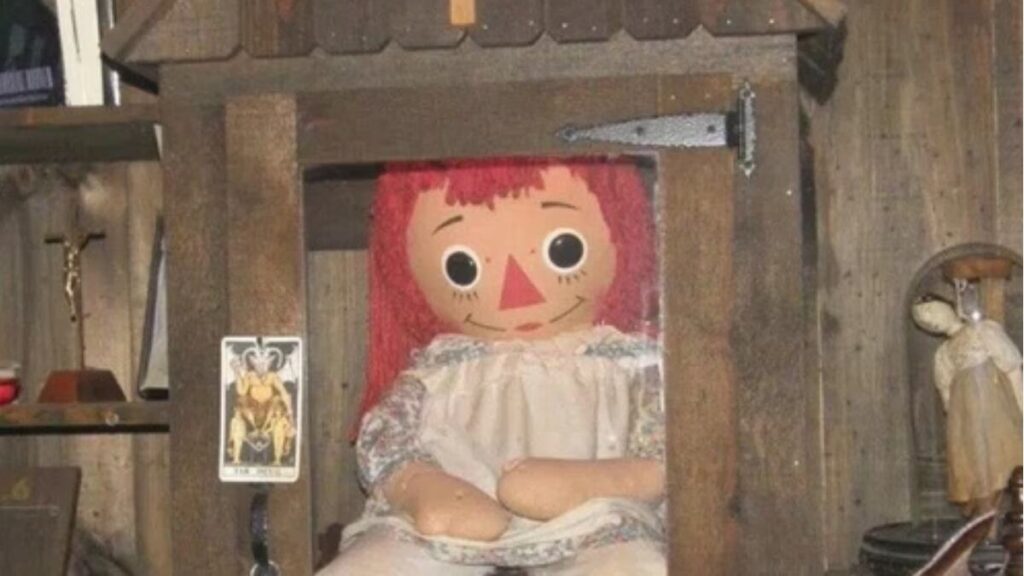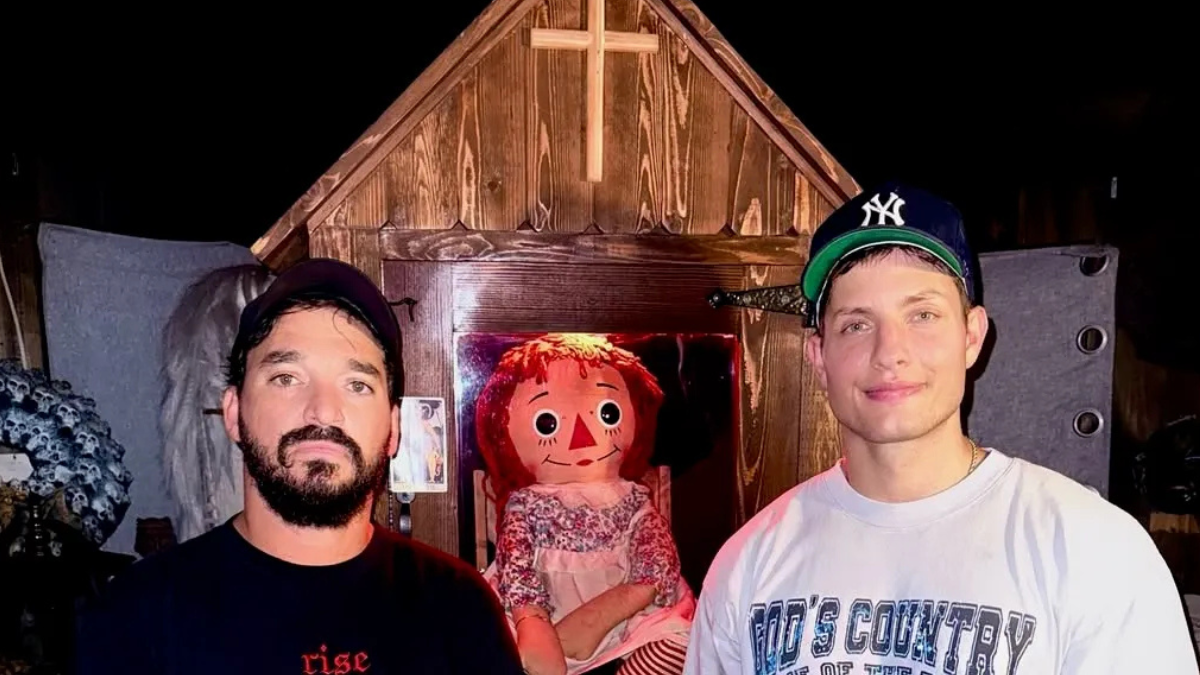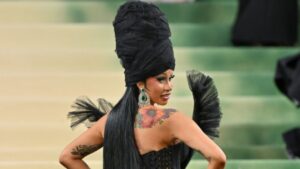Yes, that house—the one rumored to house a legacy of demonic hauntings, made infamous by Ed and Lorraine Warren, and burned into pop culture by The Conjuring films. And while most people might run screaming from such a cursed address, Rife walked straight in—on purpose. The viral comedian, known for lightning-fast crowd work and a jawline that launched a thousand TikToks, has now added “paranormal homeowner” to his résumé.
At first glance, it appears to be a publicity stunt. But dig a little deeper, and the move feels far more calculated—and weirdly brilliant. In an era when entertainers are expected to be more than just funny, Rife’s pivot taps into something bigger: a cultural obsession with the haunted, the unexplained, and the edge where entertainment blurs with experience.
So, what happens when a rising comic embraces the occult? This isn’t just about ghosts—it’s about rebranding, risk-taking, and what it means to build a career in the age of constant reinvention. Let’s step inside. … don’t touch the doll.
When Stand-Up Meets the Supernatural: Rife’s Unlikely Pivot
From TikTok to Terror: Tracing Rife’s Audience Evolution
Matt Rife’s rise wasn’t a slow burn—it was a digital supernova. One minute he was grinding out club sets, the next he was TikTok’s favorite fast-talking flirt, racking up millions of views with his off-the-cuff crowd work and razor-sharp charm. His timing, both onstage and in understanding internet culture, was flawless. As short-form video exploded, so did Rife’s presence—his clips became algorithm gold, leading to sold-out global tours and a fanbase that stretches from comedy nerds to casual scrollers.
But here’s what’s wild: that same audience—largely Gen Z and younger Millennials—didn’t flinch when he leaped into punchlines to paranormal. They learned in. This is a generation raised on BuzzFeed Unsolved, creepypasta, horror TikTok, and ironic ghost-hunting vlogs. They treat comedy and fear as two sides of the same chaotic coin.
Rife’s pivot isn’t a rejection of his roots—it’s an extension. He’s not abandoning humor; he’s remixing it with the haunted, the cursed, the meme-worthy macabre. And if anyone can make a demonic dollhouse… well, funny, it’s him.
Why Buy a Haunted House? Rife’s Public Rationale
When news broke that Matt Rife had purchased the notorious “Annabelle doll house,” the internet didn’t know whether to laugh, scream, or hit “refresh.” On Instagram, Rife played it coy—posting a blurry selfie in front of the home with the caption, “She’s got… character.” On a recent podcast appearance, he doubled down with mock sincerity: “It’s cheaper than therapy and comes with its demons.” Classic Rife—deflecting with humor, but clearly in on the performance.
But behind the punchlines, there’s intent. In interviews, he’s hinted at a fascination with fear as a “shared experience” and even called haunted houses “the last great unscripted theater.” Translation? This is more than a gimmick—it’s content, it’s community, it’s control. Buying a haunted house isn’t just owning a property; it’s acquiring a brand extension.
Whether driven by a genuine interest in the paranormal or a genius-level sense for viral storytelling, Rife is tapping into something potent: curiosity that sells. In a media landscape where spectacle wins, buying the Annabelle house might be the boldest punchline of his career.
The House That Horror Built: Inside the Lore of the Annabelle Doll Home
The Real-Life Lore Behind the Doll and the House
Long before Hollywood turned her into a porcelain nightmare, the real Annabelle was an ordinary Raggedy Ann doll—with an extraordinary reputation. In the 1970s, she landed in the hands of Ed and Lorraine Warren, the famed paranormal investigators whose case files would eventually inspire The Conjuring universe. According to the Warrens, the doll was possessed by a malevolent spirit that tormented a pair of nursing students. It wasn’t just creaky-floor horror; they claimed Annabelle moved on her own, left handwritten notes, and even tried to strangle someone in their sleep.
The Warrens took the doll into custody and sealed her in a locked glass case within their occult museum, warning that she should never be touched. As for the house? While it wasn’t featured in the films, it’s connected to the artifact’s backstory—rumored to have once stored cursed objects the Warrens investigated. It’s part myth, part museum… and now, somehow, part of Matt Rife’s brand.
What Condition Was the House In—and Did Rife Know?
When Matt Rife stepped through the front door of the so-called Annabelle house, he reportedly met a scene straight out of a low-budget horror flick—minus the special effects. Sources close to the sale describe peeling floral wallpaper, warped wood flooring that groaned underfoot, and attic stairs that looked like they hadn’t been trusted since the Carter administration. The air inside? Thick, musty, and oddly colder than it should’ve been, even for New England in spring.
Scattered throughout were relics: crosses nailed askew on door frames, an antique rocking chair that allegedly rocked itself during showings, and—of course—a locked case where a doll used to be. Whether Rife knew the full extent of the property’s history remains up for debate, but judging by his cryptic post, “She came with stories… I like stories,” he wasn’t blindsided. He was named the legal guardian of the haunted Annabelle doll and over 750 items once owned by Ed and Lorraine Warren.
Was this a stunt? Maybe. But it also feels like a calculated choice—an eerie stage for a new kind of performance. If this house was a test of nerves or narrative, Rife passed… and pressed “record.”
Rebranding with an Ouija Board: How Matt Rife Is Monetizing the Macabre
From Laughs to Lore: Shifting His Public Persona
Matt Rife used to be the guy who roasted front-row couples and went viral for smooth comebacks and cheekbones that could slice glass. But lately? The lighting’s dimmer, the music’s eerier, and the merch features pentagrams instead of punchlines. Since purchasing the Annabelle house, Rife has started leaning into something darker—and it’s no accident.
His social feeds have taken a turn from sunlit gym selfies to grainy, flashlight-lit videos captioned “Guess who didn’t sleep last night 👻.” A limited-edition merch drop— “Haunted & Handsome”—sold out in hours. He’s even teased a horror-comedy web series, with rumors swirling of cameos from actual ghost hunters and paranormal TikTokers.
It’s not a total identity overhaul, but the brand polish has gone from matte to midnight. The formerly flirty crowd-work king is now cultivating a kind of haunted charisma—think Ryan Reynolds meets The Blair Witch Project. This isn’t just about spooky aesthetics; it’s a personality expansion. Rife isn’t leaving comedy—he’s adding shadows to the spotlight. And apparently, his fans are here for the séance.
Digital Séances: Rife’s Strategic Use of Fear Content
Matt Rife didn’t just buy a haunted house—he turned it into a content engine. Almost overnight, his TikTok shifted from flirty banter and backstage bits to shadowy footage of flickering lights and unexplained whispers caught on camera. He’s launched what fans are calling “digital séances”—bite-sized horror experiments blending real (or real-ish) ghost hunting with punchline pacing. Think Blair Witch meets BuzzFeed.
On YouTube, he’s dropped reaction videos to vintage paranormal footage, staged spooky skits inside the house, and teased a recurring segment called Night Shift, where guests stay overnight to “prove it’s all BS—or not.” Instagram Reels are peppered with subtle jump scares and mysterious knocks mid-recording. Each clip is short, suspenseful, and algorithmically engineered for maximum shareability.
The strategy is smart: fear content performs. It’s emotional, repeatable, and uniquely engaging. In a creator economy fueled by watch time and comment spirals, Rife’s horror pivot isn’t just playful—it’s profitable. He’s not chasing ghosts; he’s chasing engagement. And frankly, he’s caught both.
Paranormal Is the New Punk: How Rife Fits into a Larger Trend
Matt Rife may be the latest to lean into the haunted, but he’s far from the first. He’s tapping into a booming genre where fear isn’t fringe—it’s monetizable mainstream. Welcome to the era of “scarefluencing,” where ghosts, true crime, and urban legends have become cornerstones of digital entertainment.
Take YouTubers Sam and Colby, whose haunted explorations rack up millions of views and have evolved into full-blown docu-style investigations. Or Bailey Sarian, who blended true crime with makeup tutorials to pioneer the wildly successful Murder, Mystery & Makeup format. Then there’s Loey Lane, who built a loyal audience by combining fashion, body positivity, and ghost stories—all while normalizing the paranormal.
What unites these creators isn’t just content—it’s community. Their audiences don’t just watch; they believe, speculate, and return for more. Fear content is sticky, serialized, and infinitely remixable. It thrives on suspense, reaction, and the thrill of the unknown—qualities that perfectly suit platforms like TikTok and YouTube, where Rife is already a pro.
By stepping into this space, Rife isn’t just chasing a trend—he’s blending stand-up with séance. In a culture where authenticity and spectacle now share a stage, going haunted isn’t weird. It’s strategic. And very 2025.
How Does He Stack Up? Rife vs. Other Celebrity Rebranders
Comedy Chameleons Who Pivoted and Thrived
Matt Rife isn’t the first comedian to redraw the lines of his career—and if he plays it right, he won’t be the last to thrive doing it. Just look at Bo Burnham, who evolved from YouTube teen satirist to a boundary-pushing filmmaker with Inside, blending comedy, music, and existential dread into a genre all his own. Or Kevin Hart, who scaled from stand-up to global box-office brand, launching fitness apps, production companies, and tequila ventures along the way.
Then there’s Donald Glover, the gold standard of reinvention—pivoting from sitcom punchlines (Community) to surrealist TV (Atlanta) and Grammy-winning music as Childish Gambino. Each of these shifts wasn’t random—it was calculated, authentic, and audience-aware.
The takeaway for Rife? Identity is elastic when rooted in real talent. Today’s audiences don’t expect entertainers to stay in one lane—they reward creative risk. If Rife’s haunted house era feels genuine and well-produced, it could mark not a detour, but the next chapter of a much bigger story.
But Who Else Went Spooky?
Matt Rife isn’t the first celebrity to dip a toe into the occult—but he might be the first to buy real estate for it. Post Malone famously claimed a cursed encounter with the haunted Dybbuk box led to a string of bizarre misfortunes, and Megan Fox made headlines for casually admitting she and Machine Gun Kelly drink each other’s blood “for ritual purposes.” Creepy? Sure. But also headline gold.
What sets Rife apart is how methodical his spooky shift feels. While others flirt with the aesthetic for shock or mystique, Rife is building infrastructure: content formats, branded merch, immersive experiences. This isn’t just a vibe—it’s a vertical.
Of course, the question of authenticity lingers. Is this paranormal passion or performance art? Maybe both. But in an age where audience trust is currency, the haunted brand only works if it feels lived-in. And Rife? He’s not just playing spooky—he’s sleeping in it.
The Creaks, the Cold Spots, and the Charisma
The first thing you notice isn’t the house—it’s the stillness. Not quiet. Still. Like the kind of silence that makes your spine pay attention.
I arrived at Matt Rife’s haunted house just before dusk, the sun draining color from the trees as if nature itself didn’t want to be involved. The house loomed like it knew something I didn’t. Shutters crooked, porch slanted just enough to feel off. Inside, it smelled like cedar, candle wax, and something metallic—like blood, or maybe just old pipes with a flair for the dramatic.
Rife greeted me barefoot, holding a flashlight and a protein shake. “You’re right on time,” he said with a grin. “She gets active after 10.” I wasn’t sure if he meant the house or something—or someone—inside it.
The night was a slow drip of weird. Cold spots in rooms with no vents. A locked cabinet door that opened with a soft click at 3:12 a.m. A whisper on the baby monitor he swears he doesn’t own. We filmed, laughed, got serious, and once—when a mirror cracked audibly during a Q&A—just stared at each other in stunned silence.
What struck me most wasn’t the house (though, yes, it’s unsettling) or the “paranormal activity” (which could be easily staged or eerily real). It was how comfortable Rife seemed in it. Not performative, not scared—just oddly at home. Like he wasn’t renting the haunted vibe. He bought it. Literally and metaphorically.
By sunrise, I couldn’t tell if I’d been spooked or seduced. But I knew this: the house has a presence—and so does he. Whether it’s marketing genius, a genuine haunting, or both, Rife has found something rare: a way to turn the weird into something magnetic. And yeah, I’m still sleeping with the lights on.
From Scream to Stream: Will This Haunted Move Pay Off?
The Business of Branding with Fear
Turning a haunted house into a content HQ sounds like a dare, but it might be one of Matt Rife’s smartest plays yet. In today’s creator economy—where niche is the new mainstream—owning a unique setting is like striking digital oil. Think creator houses, but with creaky floors and séance lighting.

The haunted aesthetic opens doors to horror-themed merch, exclusive fan experiences, and even streaming opportunities (imagine a Netflix docuseries titled Comic in the Cursed House). It’s sticky, serialized content with built-in suspense—and suspense keeps viewers watching.
Of course, the risks are real: if the paranormal angle feels forced or fizzles, audiences could ghost. But if Rife keeps it authentic and creatively nimble, this spooky investment could haunt the algorithm—in all the right ways.
Haunted… but Marketable
Rife’s haunted house isn’t just creepy—it’s commercially ripe. Picture this: ticketed ghost tours with a comedic twist, Halloween pop-ups hosted on-site, or exclusive paranormal podcast recordings streamed from the attic. It’s experiential branding at its most immersive.
He could easily partner with horror conventions like Midsummer Scream or collaborate with haunted content creators for cross-platform virality. A Netflix or Hulu special—Live from the Annabelle House—writes itself. Throw in limited-edition merch drops tied to alleged hauntings (“I survived Room 3”) and you’ve got a vertically integrated fear economy.
The genius here isn’t just in the spooks—it’s in the strategy. Rife has turned a single, eerie property into a multi-channel content engine. It’s haunted, yes—but also hilariously, hauntingly marketable.
The Haunted Pivot That Might Work
At first glance, Matt Rife buying a haunted house sounds like tabloid bait—another celebrity chasing shock value. But the longer you look, the more it resembles something smarter: a rebrand rooted in narrative, experience, and cultural timing. He’s not just telling jokes anymore; he’s telling ghost stories—and inviting millions of fans to sit around the digital campfire.
What makes this move resonate isn’t just the haunted backdrop—it’s the way Rife has folded it into his identity. In an age where audiences crave authenticity but are also addicted to spectacle, Rife’s haunted pivot blurs the line between myth and marketing. He’s crafted a space (both literal and metaphorical) where fear, comedy, and curiosity collide.
Maybe it’s a gimmick. Maybe it’s performance art. Maybe it’s both—and maybe that’s the point. In a culture where entertainers are expected to be brands, and brands are expected to feel like people, Rife’s gamble hits the sweet spot: creepy, compelling, and strangely credible.
The house might be haunted. But the strategy? Positively alive.
Nishant Wagh is the founder of The Graval and a seasoned SEO and content strategist with over 15 years of experience. He writes with a focus on digital influence, authority, and long-term search visibility.





2 thoughts on “Matt Rife Just Bought the Annabelle Doll House—And Turned His Brand Paranormal”